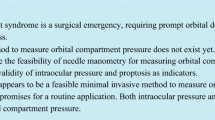Abstract
The objective of this study was to determine the effect of orbital decompression procedures on the intraocular pressure (IOP). The orbital compartment syndrome represents an emergency situation. Due to the elevated IOP vision loss may ensue. Several maneuvers including lateral canthotomy are discussed to reduce the IOP. Eight orbits were studied in a fresh frozen cadaveric model (4 specimens). Intraorbital volume was determined by CT volumetry. An orbital compartment syndrome was simulated by injecting viscous material into the orbit. Injected volumes were documented and lateral canthotomy, cantholysis, inferior and superior septolysis were performed. IOP and exophthalmometric measurements were obtained after each intervention. Controlled elevation of IOP was achieved in all specimens. IOP was partially reduced after performing a lateral canthotomy in eight orbits. IOP was significantly and sufficiently decreased under 20 mmHg by inferior cantholysis in seven orbits. An additional superior cantholysis was necessary in two orbits to achieve a complete decompression. Inferior or superior septolysis were not needed to further reduce the IOP. Lateral canthotomy must be followed by an inferior cantholysis to successfully decompress an orbital compartment syndrome in the majority of cases. Occasionally, superior cantholysis may generate additional benefit. Additional inferior and superior septolysis were not shown to provide a beneficial effect when performed after canthotomy and cantholysis.





Similar content being viewed by others
References
Caprioli J, Varma R (2011) Intraocular pressure: modulation as treatment for glaucoma. Am J Ophthalmol 152:340 e2–344 e2
Chadha NK (2012) An evidence-based staging system for orbital infections from acute rhinosinusitis. Laryngoscope 122(Suppl 4):S95–S96
Nassr MA, Morris CL, Netland PA, Karcioglu ZA (2009) Intraocular pressure change in orbital disease. Surv Ophthalmol 54:519–544
DeMere M, Wood T, Austin W (1974) Eye complications with blepharoplasty or other eyelid surgery A national survey. Plast Reconstr Surg 53:634–637
Hargaden M, Goldberg SH, Cunningham D, Breton ME, Griffith JW, Lang CM (1996) Optic neuropathy following simulation of orbital hemorrhage in the nonhuman primate. Ophthal Plast Reconstr Surg 12:264–272
Hayreh SS, Kolder HE, Weingeist TA (1980) Central retinal artery occlusion and retinal tolerance time. Ophthalmology 87:75–78
Thompson RF, Gluckman JL, Kulwin D, Savoury L (1990) Orbital hemorrhage during ethmoid sinus surgery. Otolaryngol Head Neck Surg 102:45–50
Sampath R, Shah S, Leatherbarrow B (1995) The management of an optic nerve compromising acute retrobulbar haemorrhage: report of a case. Eye (Lond) 9(Pt 4):533–535
Yung CW, Moorthy RS, Lindley D, Ringle M, Nunery WR (1994) Efficacy of lateral canthotomy and cantholysis in orbital hemorrhage. Ophthal Plast Reconstr Surg 10:137–141
Lang J. Orbita. v Lanz (1979) Wachsmut: Praktische Anatomie, Band 1 Kopf, Hrsg Lang J. Springer, Berlin
Ahmed S, Grayson MC (1994) Retrobulbar haemorrhage: when should we operate? Eye (Lond) 8(Pt 3):336–338
Thyne GM, Luyk NH (1992) Zygomatic bone fractures complicated by retrobulbar haemorrhage. N Z Dent J 88:60–63
Wood CM (1989) The medical management of retrobulbar haemorrhage complicating facial fractures: a case report. Br J Oral Maxillofac Surg 27:291–295
Zoumalan CI, Bullock JD, Warwar RE, Fuller B, McCulley TJ (2008) Evaluation of intraocular and orbital pressure in the management of orbital hemorrhage: an experimental model. Arch Ophthalmol 126:1257–1260
Oester AE Jr, Fowler BT, Fleming JC (2012) Inferior orbital septum release compared with lateral canthotomy and cantholysis in the management of orbital compartment syndrome. Ophthal Plast Reconstr Surg 28:40–43
McCartney DL, Char DH (1985) Return of vision following orbital decompression after 36 hours of postoperative blindness. Am J Ophthalmol 100:602–604
Tsikoudas A, Thiel G, Blenke E, McDougall G (2006) Endonasal bilateral simultaneous orbital decompression. Hippokratia 10:167–170
Pezato R, Pereira MD, Manso PG, Santos Rde P, Ferreira LM (2003) Three-wall decompression technique using transpalpebral and endonasal approach in patients with Graves’ ophthalmopathy. Rhinology 41:231–234
Moe KS, Jothi S, Stern R, Gassner HG (2007) Lateral retrocanthal orbitotomy: a minimally invasive, canthus-sparing approach. Arch Facial Plast Surg 9:419–426
Conflict of interest
There were no potential conflicts of interest of any of the authors.
Author information
Authors and Affiliations
Corresponding author
Rights and permissions
About this article
Cite this article
Haubner, F., Jägle, H., Nunes, D.P. et al. Orbital compartment: effects of emergent canthotomy and cantholysis. Eur Arch Otorhinolaryngol 272, 479–483 (2015). https://doi.org/10.1007/s00405-014-3238-5
Received:
Accepted:
Published:
Issue Date:
DOI: https://doi.org/10.1007/s00405-014-3238-5




